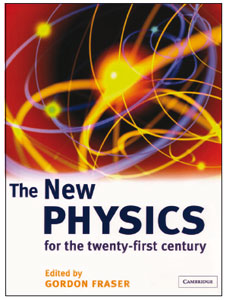By Gordon Fraser (ed.), Cambridge University Press. Hardback ISBN 9780521816007, £30 ($60).
Seventeen years ago a book called The New Physics illuminated – vividly for the layperson and sensibly for the student – a series of scientific advances and philosophical obsessions, and it trailed them as signposts for the future. As so often happens, the future went off in a somewhat different direction. While Paul Davies was editing the first volume, physicists wondered loudly and publicly about dark matter and cosmic strings; black holes and the end of time; grand unification theory and cosmic inflation; the new window on the universe by the yet to be launched Hubble Space Telescope; and the claim by the Nobel prize-winner Luis Alvarez that an asteroid had crashed into the planet 65 million years ago and ended both the Cretaceous era and the dinosaurs. In fact, Alvarez and his planet-bruising bolide never got a mention in the Davies volume, but at the time there seemed quite a lot else to be getting on with.

What a difference the decades make. In the past 17 years, experimental physicists have delivered a fifth state of matter in the Bose–Einstein condensate; slowed light down first to walking speed and then to a complete standstill; dropped the idea that time might run backwards and instead proposed interminable heat death in an ever expanding cosmos; demonstrated quantum entanglement and teleportation; mapped the fluctuations in the cosmic background radiation; introduced branes and apparently dropped cosmic strings; and discovered dark energy in a big way – so big that it accounts for three-quarters of everything. Nanotechnology emerged as both engineering obsession and practical investment, amid royal alarm in the UK about global death by grey goo. The Hubble telescope went up with a faulty mirror, and NASA launched its International Space Station but seemed to run out of steam. Global warming – physics at a practical level for most people – announced its arrival with a procession of record temperatures globally, and the debate about the Cretaceous catastrophe flowered into a much larger argument about asteroid impact-warning and deflection.
Physics never seemed so glamorous, but student numbers continued to fall and university departments continued to close. The old New Physics didn’t look so new and now CERN’s own Gordon Fraser has produced a companion volume of 19 essays, just as substantial, just as wide-ranging, and in some cases just as much fun.
Physics is not easy (it is after all done by PhDs, not dilettantes) but each essay begins comprehensibly and even enticingly, before diving quite briskly into mathematics, hard argument and occasionally hostile language. (Did Michael Green, writing about superstring theory, really have to head a section “beyond the naive perturbative approximation”?) Chris Quigg looks at particle physics and puts the Large Hadron Collider handsomely in its scientific context. But Fraser plays no special favourites. Nanoscience is there, and the Grid, and there are welcome surveys of biophysics and medical physics; the last essay is a reminder that without the physics of imaging, some neuroscience would be little more than voodoo.
All the classical preoccupations – cosmology, astronomy, gravity and the quantum world – get a fresh look. Robert Cahn’s survey of the physics of materials is a big help for the benighted. Ugo Amaldi ends the volume with a handsome canter through the connections between physics and society, and echoes many of the themes tackled in the book’s previous 18 chapters. The bad news is that physics still has an image problem. The good news is that this time Alvarez gets a mention, although not for bolide impacts, dinosaurs or the present concerted international effort to identify and track near-Earth objects. No, he gets a mention for not solving the world’s energy crisis: to be fair, for admitting that, for a few exhilarating moments, he thought that he had solved the world’s fuel problems for all time by fusing a proton with a deuteron to form helium-3. This anecdote appears, a little unkindly, under the heading “usable knowledge”.







